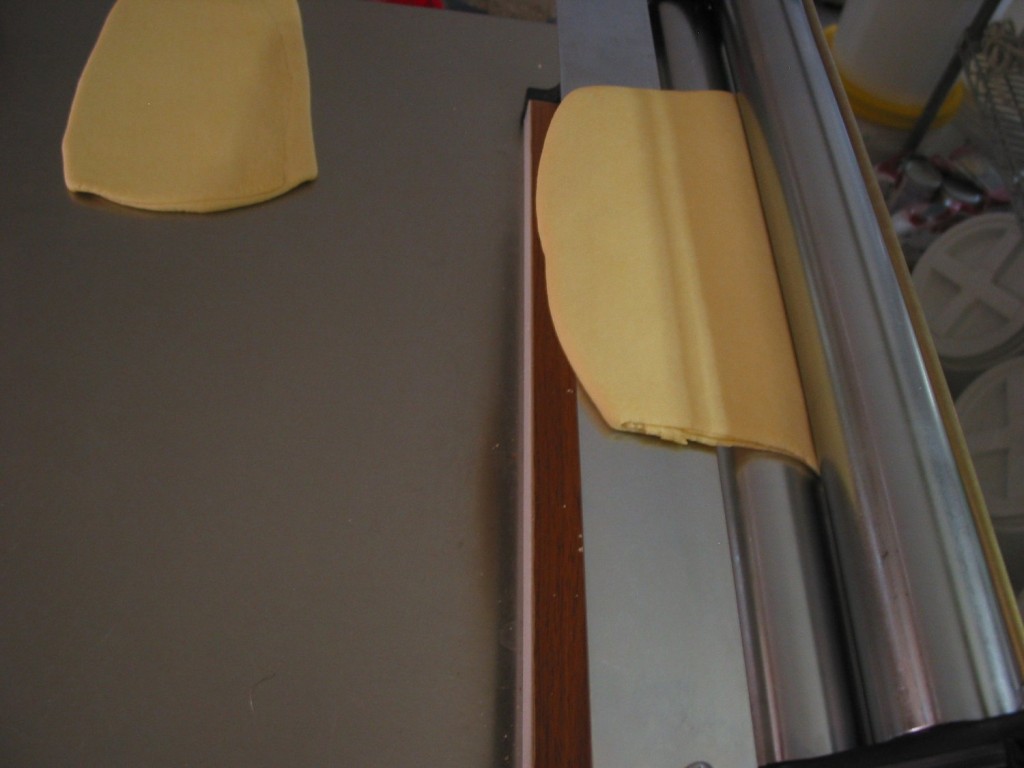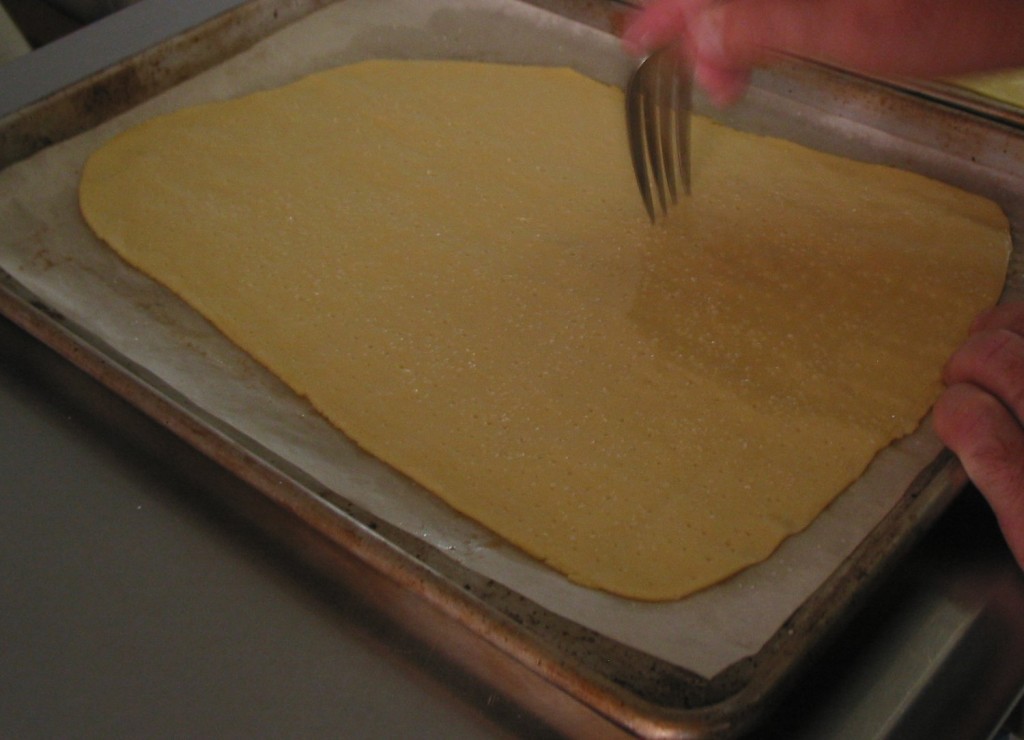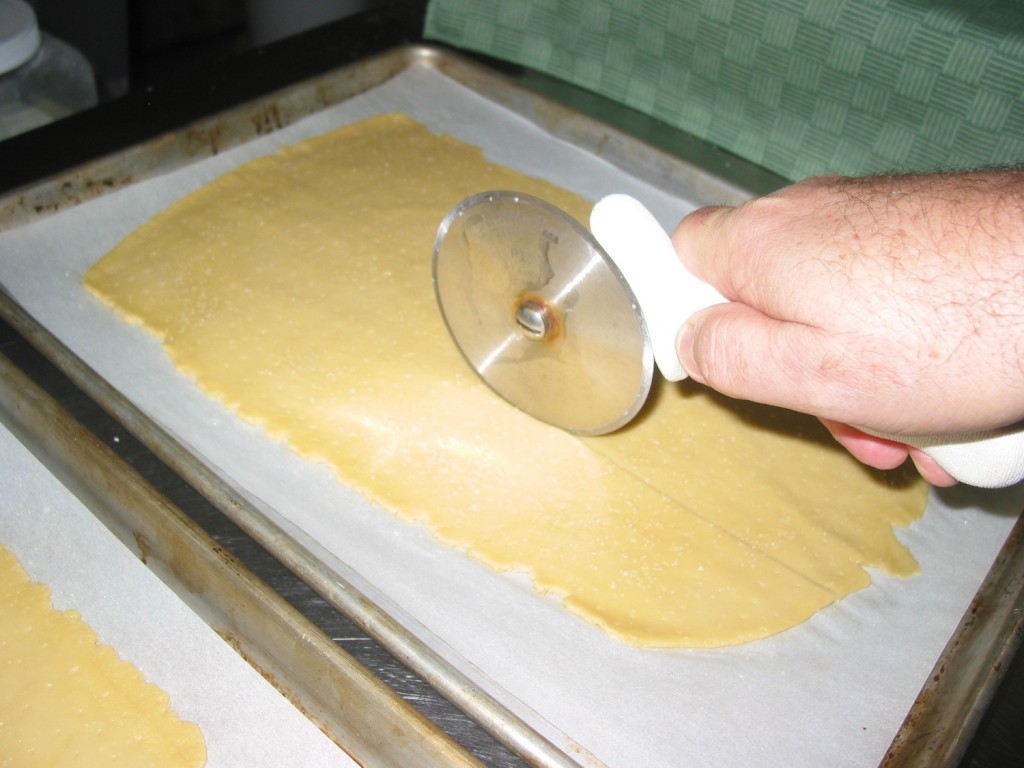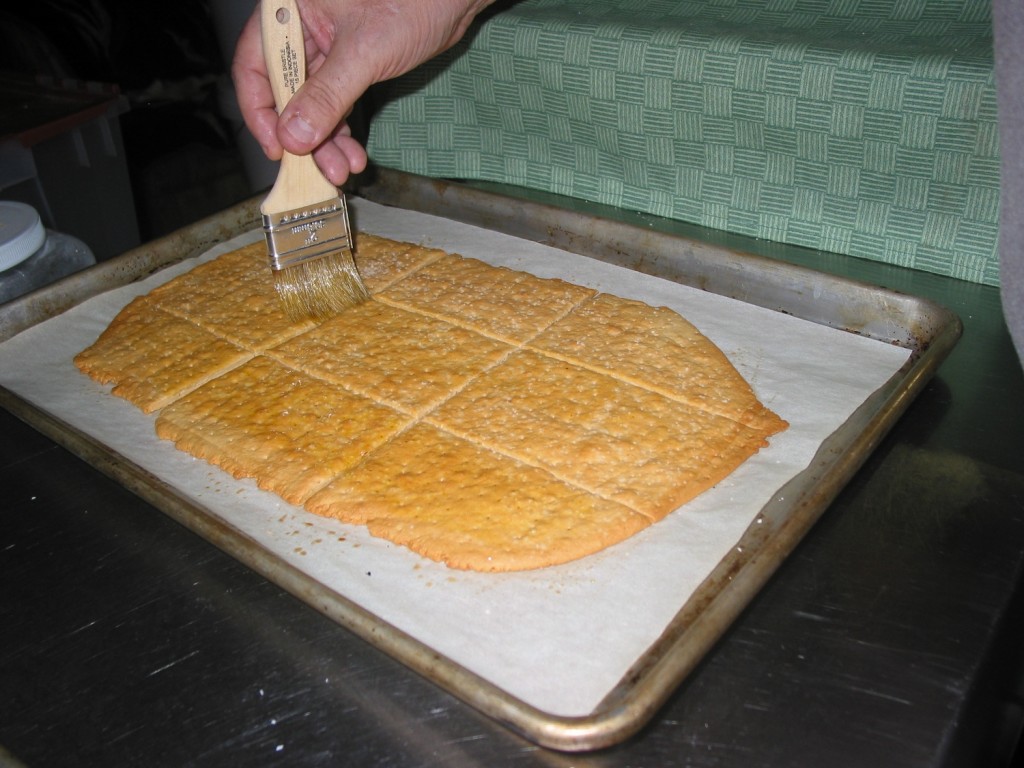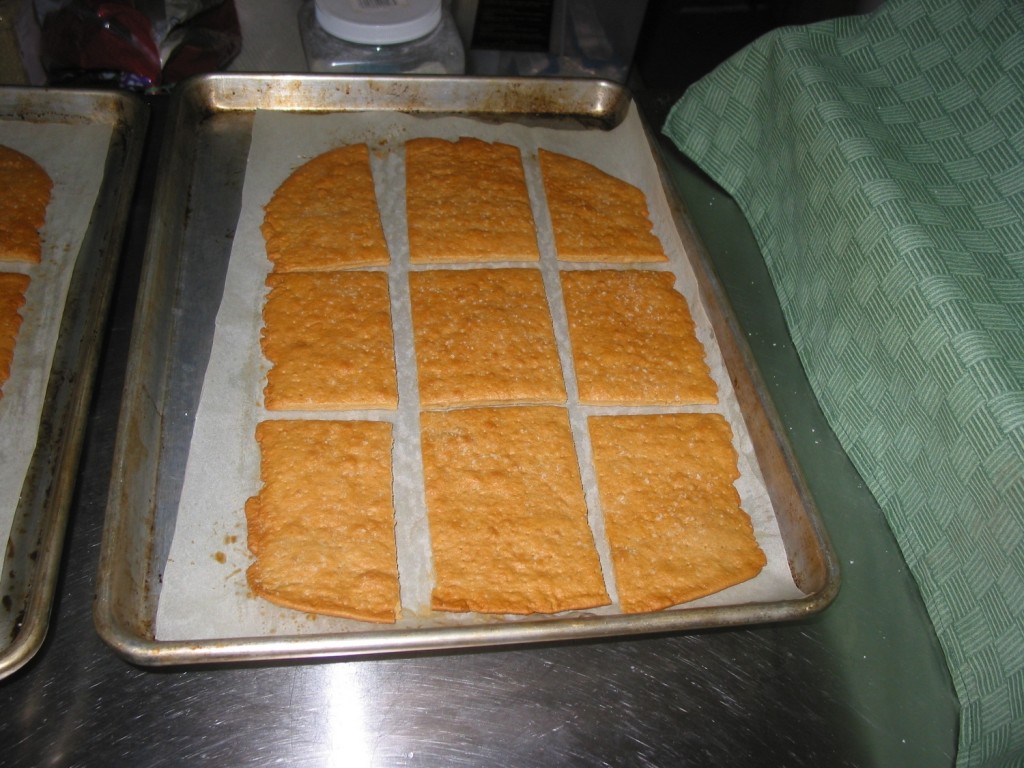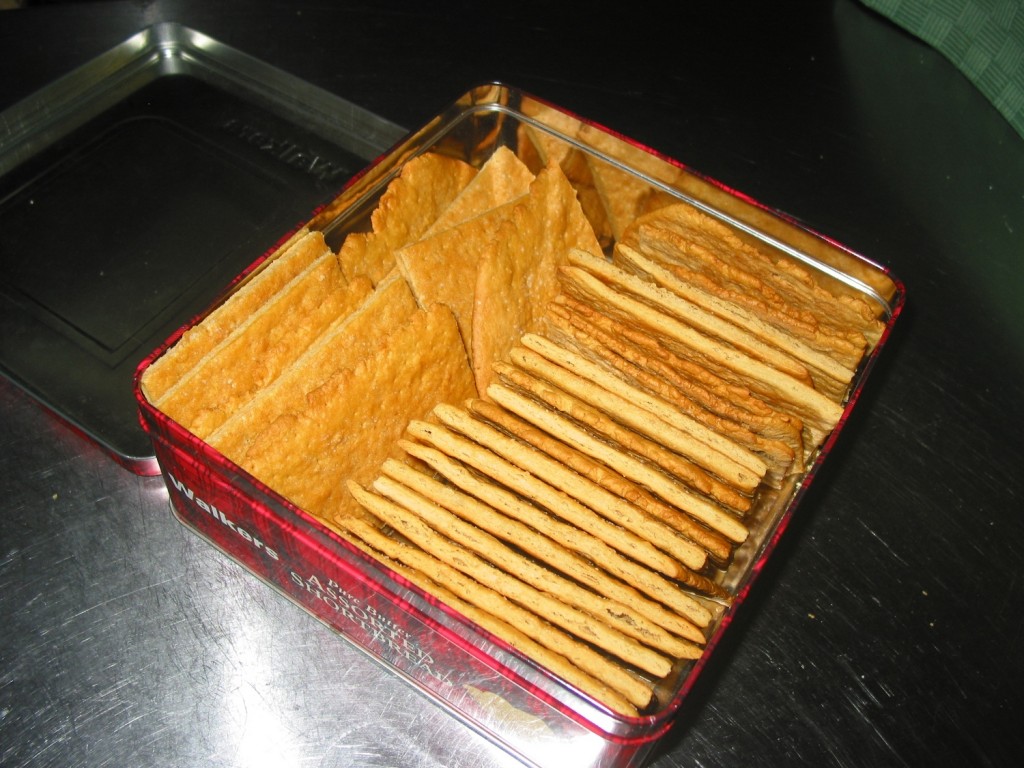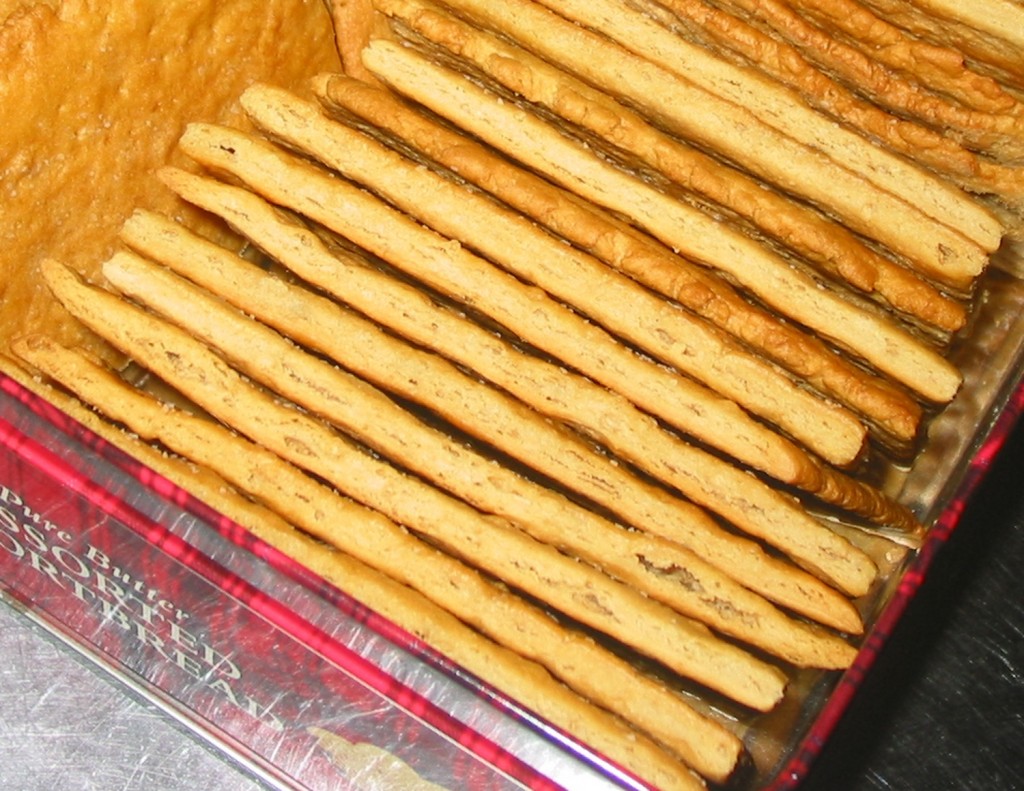I’ve been wanting to make my own crackers for some period of time. One of the problems with doing so is that the crackers are usually much tougher than store-bought varieties. I have discerned a method of decreasing the toughness of wheat flour, simply by reading science reports. I’ve never before seen a similar cracker technique in any cookbook I’ve read, though it wouldn’t surprise me if a similar technique has not been documented somewhere.
The following formula is written in bakers’ percent notation, except for one entry which I have deemed a “sub-percent.” As with any bakers’ percent, 100% is the total flour weight, and is deemed any desired flour weight. In this formula 100% is split between 20% enzyme-ferment (similar to a pre-ferment) and 80% final dough. The enzyme-ferment dough has the proteolytic agent bromelain added, which is followed by an incubation period, in order to reduce protein creating greater tenderness in the final baked product. The amount of bromelain used will vary depending upon the strength and brand purchased. The amount listed below is for the brand I purchased and numerically assigned so usage is equivalent to 1 GDU per 4 grams flour. GDU means gelatin digesting unit. How I calculated that strength is explained below, after the bakers’ percent based formula.
Buttery-flavored cracker formula with enzyme ferment
Enzyme ferment
- 20% pastry flour, white, unbleached
- (0.0205%*) bromelain (sub%* equivalent to 1 GDU per 4 g flour)
- 31% water, heated to at least 170 °F & cooled to 100 °F (sanitized then cooled)
Weigh and mix flour and bromelain in a mason jar or equivalent, add cooled water, mix well with appropriate tools, put lid on jar, then incubate for 4 hours in a water bath of 100°F, stirring and checking temperature at least every hour, adjusting any temperature controls as needed. I use a thermostatic hotplate to keep the water bath at that temperature, and once iteratively set it will keep temperature within +/- 1.5-to-2.0 °F. I usually shake the ferment jar roughly once per hour, though I don’t know if it’s required.
To calculate the bromelain sub-percent*: the total flour weight times enzyme-ferment flour percent of 20% times the bromelain sub-percent of 0.0205% results in the bromelain powder weight. It is worth noting if you try this with a different brand of bromelain, 0.0205% will likely be incorrect and you will have to calculate a different sub-percent which is equivalent to 1 GDU per 4 g flour. How to calculate that is explained below, after the cracker formula.
After the elapsed incubation time, add:
- 8% sugar (sucrose)
- 1% liquid malt extract (optional)
- 1% salt
Replace the lid and shake, or otherwise mix well. The above enzyme-ferment may be frozen for later thawing and use. If using it immediately, set it aside momentarily, to prepare the final dough.
Final Dough
- 80% Pastry flour
- 15% Buttery-flavored oil (popcorn-topping oil)
Combine flour and oil and mix until oil is very well dispersed throughout flour.
Then add leavening:
- 1% ammonium bicarbonate (baker’s ammonia)
- 3% Baking powder, non-aluminum, true double-acting
(SAPP & CAP & soda, no aluminum)
Mix well. Then add the previously set aside enzyme-ferment, and continue mixing for several minutes. This dough will remain somewhat crumbly. When done, divide and make up as needed. It is rolled with a dough roller until it is quite thin, 1/8-1/16″, then it is placed on a baking sheet.
Note 1, When using a precise and constant number of weight units on each baking tray, the thickness will always correlate to the area. The thinner the dough is rolled, the more area it will cover.
Note 2, The use of an aluminum containing baking powder will likely leave a perceptible metallic flavor in the leaner dough of a cracker versus that of a cookie which has a lot more fat and sugar. It’s a bit difficult to find non-aluminum baking powders, but they are available online. Provided there’s no moisture left in the baked product, baker’s ammonia leaves no perceptible aftertaste, but it seems to release its gas all at once, in a narrow temperature range, so I believe mixing it with a baking powder with the listed ingredients of SAPP (sodium acid pyrophosphate), CAP (calcium acid phosphate, aka monocalcium phosphate), and soda seems to give an extended range of temperatures when out gassing occurs. Alternative leavenings may include 3-4% bakers’ ammonia only, or instead, 3-4% baking powder only, or any one of a number of other leavening combinations, though the precise amounts would have to be tested then adjusted. It’s possible yeast might even work.
Sugar water
- 2% sugar
- 4% water, boiling hot
Mix hot water and sugar, stir to dissolve all sugar, and let cool. Brush on or paint dough sheet with sugar water to hold topping salt in place. This application brush will be wet, and cannot be used to pick up and spread the topping oil, below, until it has fully dried. My solution is to have two brushes, one that’s used for the sugar water, and another for the oil.
It’s possible that sucrose-based invert syrup could be used instead of sugar, then the syrup and water could probably be mixed cold. Invert syrup is easy enough to make.
- 1% salt for topping (suggest coarser salt)
Immediately after applying the sugar water, the topping salt is sprinkled on top, then the sheets are docked (lots of little holes punched, I simply use a large serving fork)
Final cracker size is cut with a wheel-style pizza or pasta cutter. I don’t have one of the small ones, which might work better, so I use the big one.
Baking temperature and time is highly dependent upon the final thickness of the rolled dough, as well as the uniformity of the thickness. The following baking instructions should be considered approximate.
Bake for 20 minutes at 350 °F, then remove from oven.
Topping or brushing oil
- 7% Buttery-flavored oil (popcorn-topping oil)
While still hot, buttery-flavored oil is brushed on the top surface. A 2″ natural-bristled brush is pictured, so it gives an idea as to the size of each cracker. Brushing on the oil is much like painting a wall, first you have to pick oil up on the brush, then apply it to the cracker. Your brush must either be dry, or only have been used previously for oil. I pick up oil for each row, first brushing only lengthwise, then later crosswise, then diagonals, to spread the oil evenly, picking up any more oil for application as needed.
Allow to cool for a short time, no more than 20 minutes. Return to oven for a second bake for 6 more minutes, remove, and allow to cool. Once cool, crackers will easily snap apart along wheel cuts.
They’re all cut by hand and slightly irregular in size, so I sort them by size and shape, then pack them in an old, saved and reused tin. This batch of crackers represents 700 g or a little over 1.54 lbs of flour weight, which calculating from formula percent minus water percent should weigh in the neighborhood of about 973 g or 2.1 lbs total.
A close up of the edges, to see the leavening effects.
Discussion
Calculate the sub percentage*
Sub percentages are not asserted as a formal part of bakers’ percentages. As it is used in this formula, use of the sub-percentage of bromelain, 0.0205%, is defined as the total flour weight times the enzyme-ferment baker’s percent (b.%) times the bromelain sub-percent. I prefer thinking of it this way, instead of multiplying the bromelain percent upward to the bakers’ percent level, which obscures the sub ratio. Let’s say the total flour weight is 700 g, then using the formula above: 700 g x 20% x 0.0205% = 0.0287 g
Background
I wanted to make some homemade crackers, but all purpose flour resulted in a somewhat tough cracker. I thought that maybe white pastry flour made entirely from soft wheat would make a more tender cracker. The pastry flour I obtained was roughly 9% protein. However, crackers made from it, while not quite as tough as when using all purpose flour (about 10.3% protein) they were still a bit tougher than commercial crackers.
I began to wonder if I could digest some of the protein to make an even more tender cracker, but still maintain the full wheat flavor. It was time to search for proteolytic agents. I had never seen any such enzymes in the baking isle of the grocery store, though maybe I missed them. It ended up that Tanabe, Arai, and Watanabe provided some answers in Modiï¬cation of Wheat Flour with Bromelain and Baking Hypoallergenic Bread with Added Ingredients. Besides the use of bromelain, they suggested several different incubation routines for complete modification of the wheat proteins, making it suitable for consumption by folks allergic to wheat, they said. My demands were not as rigorous, I just wanted to dissolve some of the proteins for tenderness. A big plus for me was bromelain’s wide U.S. availability, it can be found at nearly any vitamin store.
I wondered about the process of applying it to cracker making, and I realized at some point if I treated only a percentage of the flour, perhaps a typical pre-ferment percentage, the cracker may retain enough gluten to retain some leavening gases, provided that I didn’t use so much bromelain that it would also dissolve the protein in the final dough flour, thus I wanted to find a minimum value of bromelain to use.
Determining the minimum needed GDUs of bromelain.
I purchased some bromelain. There were many different sizes and strengths to choose from. The bromelain’s label which I purchased asserted that 2 tablets equaled 2000 GDUs (Gelatin Digesting Units). I placed a couple of tablets on the jewelry scale and found they weighed 0.82 g each. This means that the particular brand I purchased, 0.82 g = 1000 GDUs. Thereafter I powdered the tablets with a pestle and placed them back in the bottle for storage in the refrigerator. One tablet weight of 0.82 g divided by 1000 GDUs means a powder weight of 0.00082 g equals 1 GDU.
I needed to run some cracker tests to learn how many GDUs per unit weight of flour were required to result in a more tender cracker. For the enzyme-ferment I settled on a value of 20% of the total flour (leaving 80% for the final dough), mixed that 20% with a desired amount of bromelain and all the formula’s water, then incubated that for 4 hours at 100 °F. This procedure is similar to Tanabe, Arai, and Watanabe’s, though I wasn’t concerned with creating hypoallergenic wheat, I was just trying to tenderize. After the incubation period I would make a final dough and bake a batch of crackers. My formula calls for 31% water based on the total flour weight, but if I add all of it to the enzyme ferment, and since that ferment was only 20% of the total flour, the adjusted hydration rate calculates to 155% of the ferment’s flour weight (31% ÷ 20% = 1.55 = 155%), hopefully enhancing proteolytic activity during the incubation. The bromelain enzyme-ferment is about the hydration of a pancake batter. It’s thinner than a poolish, and without any yeast. I use a small thermostatic stove that has a setting that allows a pan of water to be kept at approximately 100 °F. The enzyme ferment is placed in a glass container, and that container is placed in a larger pan holding the water bath for the incubation. A digital thermometer is a needed piece of equipment to verify all temperatures, the water-bath temperature is frequently checked, the thermostat setting adjusted as needed.
The first bromelain value I chose to use was the equivalent of 1 tablet weight, 0.82 g. If it is mixed with 100 g flour it can be conceived as a baker’s percent of 0.82%, which allows it to be proportioned for any flour amount, and which results in a rate of 1000 GDUs per 100 g flour. This amount was plenty, the baked crackers were more tender, but I wanted to find a minimum value. I reduced the amount by a factor of ten, 0.082%, or 100 GDUs per 100 g of flour, and found this was still an adequate amount which resulted in tender crackers. The next baking test I reduced it once again by a factor of 10, I used 0.0082%, or 10 GDUs per 100 g of flour, and found that the crackers were just as tough as if I had made them without bromelain, or so they seemed in my subjective “crunch” test (chewing & eating them). Further testing proved to me that a value somewhere between 17.5 and 50 GDUs per 100 grams of flour, and preferably 25 GDUs, was roughly the acceptable minimum number needed to obtain tender crackers when using the 4-hour incubation at 100 °F and when the hydration is about 155% of the flour weight.
| test # |
bakers % |
bromelain weight |
GDUs per 100 g flour |
result |
| 1 | 0.82% | 0.8200 | 1000 | tender |
| 2 | 0.082% | 0.0820 | 100 | tender |
| 4 | 0.041% | 0.0410 | 50 | tender |
| 5 | 0.0205% | 0.0205 | 25 | tender, maybe slightly less so |
| 6 | 0.01435% | 0.01435 | 17.5 | not tender! |
| 3 | 0.0082% | 0.0082 | 10 | not tender! |
It would be possible to further refine the values between 17.5 and 25 GDUs, and to adopt a less subjective testing method, but for my purposes, which was to make tender crackers using a technique not mentioned in any cookbook I’ve seen, this seemed close enough.
25 GDUs per 100 g flour worked well enough, and is equivalent to 1 GDU per 4 grams of flour. The tablet weight divided by its GDU specification equals the weight per single GDU, in the case of the bromelain I purchased, 0.00082 g per 1 GDU. To calculate the equivalent weight of bromelain to use in the cracker formula, 25 multiplied by 0.00082 (the above calculated g per GDU of the particular bromelain tablets I purchased) results in the value 0.0205 g and I deemed it per 100 g flour. This is equivalent to 0.0205% when expressed as a sub-percent of the enzyme-ferment’s flour weight. The total flour weight times 20% (for enzyme-ferment flour weight) times the sub-percent of 0.0205% results in the bromelain powder weight to add to the enzyme-ferment.
Additional Materials
My kitchen worksheet, a large image
